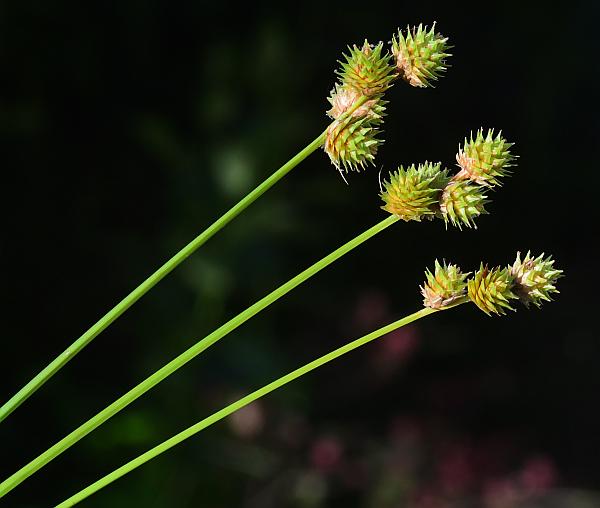Carex molesta Mack.
Troublesome Sedge

Native
CC = 3
CW = 0
MOC = 90
© SRTurner
Carex molesta Mack.Troublesome Sedge | |
 |
Native CC = 3 CW = 0 MOC = 90 |
© SRTurner |
|
Family - Cyperaceae Habit - Monoecious sedge with short, inconspicuous rhizomes, forming tufts or clumps. Stems - Flowering stems 25-100 cm long, much longer than the leaves. Vegetative stems shorter than the flowering stems and developing late in the season, the leaves clustered near the tip. Leaves - Leaves with well-developed blades mostly 3-7 per flowering stem. Leaf blades 2-30 cm long, 2-3 mm wide, light green to green. Leaf sheaths often extended past the insertion point of the leaf blade, the ventral side white to light yellow, papery, the tip truncate to somewhat concave, the ligule mostly wider than long and U-shaped.
Inflorescences - Mostly stiffly erect, the 2-5 spikes densely overlapping along the axis, the lowermost spike sometimes more loosely spaced, the internode between the lowermost spikes mostly 2.5-6.0 mm long. Spikes 6-15 mm long, 5-10 mm wide, the pistillate portion circular to broadly ovate or obovate in outline, rounded at both ends, with usually numerous perigynia with ascending or more commonly spreading tips, the staminate portion usually inconspicuous.
Perigynia - Scales 2.5-5.0 mm long, shorter and narrower than, but not hidden by the perigynia, narrowly ovate, rounded to bluntly pointed, white to light yellowish brown with a green or pale brown midrib. Perigynia 3.4-5.4 mm long, 2-3 mm wide, 1.3-1.8 times as long as wide, flat to slightly concave on the ventral side and somewhat convex on the dorsal side, the main body as long as wide or slightly longer than wide, broadly ovate-elliptic, widest at or below the middle, broadly winged to the base, rounded gradually to a beak with toothed or roughened margins, the wing extending to the tip of the beak, the ventral and dorsal surfaces lacking papillae, sharply 3-7-nerved on the ventral surface and finely 6-11-nerved on the dorsal surface, pale brown to light tan. Fruits 1.2-2.0 mm long, 0.9-1.3 mm wide, 1.3-1.6 times as long as wide, elliptic to narrowly oblong in outline, light brown to brown.
Flowering - May - July. Habitat - Bottomland prairies, moist depressions of upland prairies, bottomland and mesic forests, streambanks, pond margins, pastures, ditches, moist disturbed areas. Origin - Native to the U.S. Lookalikes - C. brevior, C. festucacea, many others. Other info. - This sedge is found throughout Missouri and is common, being somewhat more tolerant of disturbance than many others. Beyond Missouri its range extends across large portions of the upper Midwest, New England, and Canada. As a member of the Ovales section it has numerous lookalikes, and a confident ID requires practice and close examination. Look for plants having a few closely-spaced, nearly spherical spikes at the tips of the long, slender culms. The spikes look a bit like tiny artichokes with spreading "leaves." The staminate portion is at the base of the terminal spike, and is usually inconspicuous. Photographs taken at Robertsville State Park, Franklin County, MO, 6-10-2020 (SRTurner). |